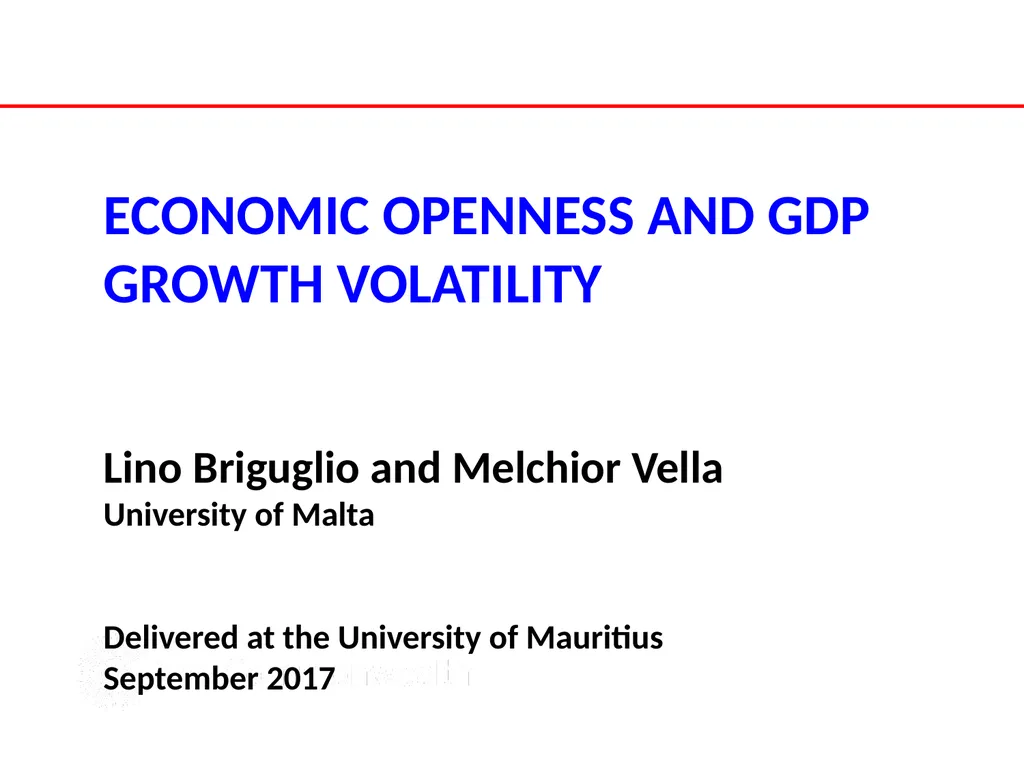ECONOMIC OPENNESS AND GDP growth volatility Lino
Author : natalia-silvester | Published Date : 2025-11-08
Description: ECONOMIC OPENNESS AND GDP growth volatility Lino Briguglio and Melchior Vella University of Malta Delivered at the University of Mauritius September 2017 1 INTRODUCTION The objective of this presentation is to test whether trade openness
Presentation Embed Code
Download Presentation
Download
Presentation The PPT/PDF document
"ECONOMIC OPENNESS AND GDP growth volatility Lino" is the property of its rightful owner.
Permission is granted to download and print the materials on this website for personal, non-commercial use only,
and to display it on your personal computer provided you do not modify the materials and that you retain all
copyright notices contained in the materials. By downloading content from our website, you accept the terms of
this agreement.
Transcript:ECONOMIC OPENNESS AND GDP growth volatility Lino:
ECONOMIC OPENNESS AND GDP growth volatility Lino Briguglio and Melchior Vella University of Malta Delivered at the University of Mauritius September 2017 1. INTRODUCTION The objective of this presentation is to test whether trade openness leads to economic volatility, keeping other relevant things constant. This theme has been investigated in various studies, as we shall show in the literature review. However this particular study place the analysis within the vulnerability/ resilience framework, proposed by Briguglio et al. (2009). One would expect that if a country depends highly on economic conditions in other countries, its economic situation will also be highly exposed to external shocks, possibly leading to GDP growth volatility in the country in question. Likewise, a high dependence on imports is likely to lead to a high degree of exposure to economic conditions in the rest of the world. There are other reasons why trade openness leads to GDP growth volatility - these will be discussed in the section on the literature. Objective of the presentation 1. Introduction The hypothesis to be tested in this paper is that GDP growth volatility depends on trade openness, on economic governance and on the stage of development of a given economy, the latter variable possibly proxying social and political governance in the country concerned. The approach to be used to test this relationship is the regression method, using panel data. This proposed relationship is an extension of the arguments put forward by Briguglio et. al (2009) and Briguglio (2016), where factors that lead to economic vulnerability were juxtaposed against factors that lead to economic resilience in order to assess the risk of a country being harmed by external shocks. These two studies were not based on regression analysis, but on observations of variables that lead to economic vulnerability and resilience, which enabled the authors to classify countries, in terms of the so-called vulnerability and resilience (V&R) framework. The present study attempts to statistically test this relationship. The hypothesis 1. Introduction The confirmation of the hypothesis of this study may help to explain the so-called “Singapore paradox” referred to in Briguglio et al. (2009), meaning that highly-open economies can and do generate high GDP per capita in spite of the fact that openness, by itself, tends to generate volatility, which is often considered to be harmful to growth. The possibility that GDP growth volatility is influenced by economic, social and political governance, may













